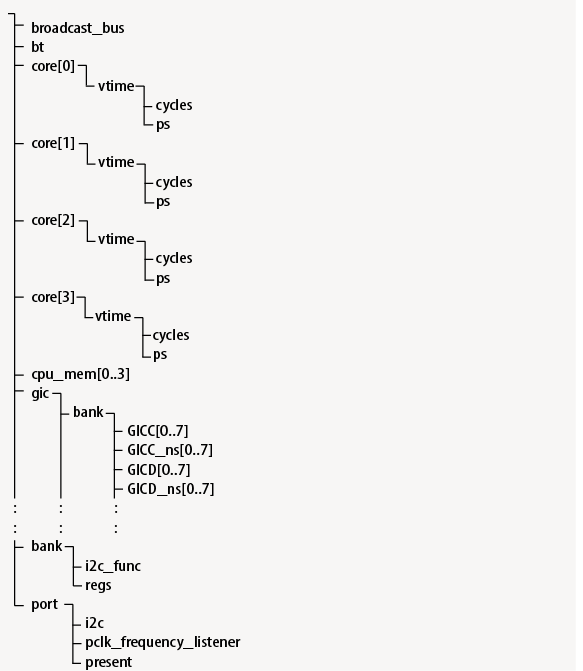Visible to Intel only — GUID: kyk1679234701251
Ixiasoft
Visible to Intel only — GUID: kyk1679234701251
Ixiasoft
5.4.1. Listing Objects in the Target System
list-objects ["iface"] ["class"] [namespace] ["substr"] [-n] [-a] [-all] [-recursive] [-tree]
| Command | Description |
|---|---|
| ["iface"] | Only lists objects with a particular interface. |
| ["class"] | Only lists objects of a particular class. |
| [namespace] | Lists all objects inside the given namespace. |
| ["substr"] | Lists all objects containing the given substring – especially useful with –all. |
| -n | Sorts by name instead of by class. |
| -all | Lists objects anywhere in the configuration. |
| -recursive | Lists objects in the current namespace and below. |
| -tree | Prints a tree structure similar to the view in the System Editor. |
In the Intel® Simics® simulator CLI, enter the list-objects command. You see that the namespace agilex (which is an object by itself) is defined in the class sm_hps_board. The agilex is the namespace for the target board HPS hardware system. Other name spaces are ethernet_switch0, fpga0, and service_node_cmp0. Names might vary on different systems.
# Intel Simics simulator CLI # You can use “list-objects” with or without stopping simics. simics> list-objects ----------------------------------------------------------------------------- Component Class Object ----------------------------------------------------------------------------- <ethernet_switch> ethernet_switch0 <service_node_comp> service_node_cmp0 <sm_universal_system_comp> system <sm_universal_board_comp> system.board <sm_universal_fpga_comp> system.board.fpga <sm_ghrd_qsys_top_comp> system... <sm_ghrd_subsys_hps_comp> system...hps_subsys <vp_intel_agilex_5_soc> system..._subsys.agilex.hps : ----------------------------------------------------------------------------- ------------------------------------------ Class Object ------------------------------------------ <bp-manager> bp <breakpoints-old> breakpoints <sync_domain> default_sync_domain <script-params> params <preferences> prefs <sim> sim ------------------------------------------
You can inspect the objects under system.board.fpga by entering list-object namespace = system.board.fpga. This returns a list of all objects. The output list can be very long.
# Intel Simics simulator CLI simics> list-objects namespace = system.board.fpga ------------------------------------------------------------------------- Component Class Object ------------------------------------------------------------------------- <sm_ghrd_qsys_top_comp> system... <sm_fabric_example_design_comp> system...example_design <sm_ghrd_subsys_hps_comp> system...hps_subsys <vp_intel_agilex_5_soc> system...hps_subsys.agilex_hps <txt_console_comp> system...hps_subsys.agilex_hps.console0 <sm_hps_usb31_comp> system...hps_subsys.agilex_hps.usb31 <sm_emif_hps_comp> system...hps_subsys.emif <sm_sdm_bb_comp> system...hps_subsys.sdm <sm_ghrd_subsys_periph_comp> system...periph_subsys <sm_fabric_example_design_comp> system...periph_subsys.example_design_lw ------------------------------------------------------------------------- ------------------------------------------------------------------- Class Object ------------------------------------------------------------------- <connector> system.board.fpga.gpio_in0[0] <connector> system.board.fpga.gpio_in0[1] <connector> system.board.fpga.gpio_in0[2] : <sm_hps_qspi.sram_pio> system...hps_subsys.sdm.qspi.port.sram_pio : <crypto_engine_sha256> system...hps_subsys.sdm.sha256_engine : -------------------------------------------------------------------
To further inspect the details of an object, enter command list-objects namespace = [namespace].[object]. Use the -tree option to view the object connections as a hierarchy. To view the table and tree representation of the HPS hardware system, enter commands as follows.
# Intel Simics simulator CLI # using object “agilex.hps” as an example simics> list-objects namespace = system.board.fpga.soc_inst.hps_subsys.agilex_hps ----------------------------------------------------------------------- Component Class Object ----------------------------------------------------------------------- <vp_intel_agilex_5_soc> hps (alias for system...hps_subsys.agilex_hps) <txt_console_comp> system...hps_subsys.agilex_hps.console0 <sm_hps_usb31_comp> system...hps_subsys.agilex_hps.usb31 : ----------------------------------------------------------------------- ----------------------------------------------------------------------- Class Object ----------------------------------------------------------------------- <sm_hps_smmu_marker> system...hps_subsys.agilex_hps.access_marker <frequency_bus> system...hps_subsys.agilex_hps.boot_clk : <sm_hps_wdt4.SRESET> system...hps_subsys.agilex_hps.wdt4.port.SRESET <sm_hps_wdt4.preset> system...hps_subsys.agilex_hps.wdt4.port.preset ------------------------------------------------------------------------- simics> list-objects namespace = system.board.fpga.soc_inst.hps_subsys.agilex_hps -tree

- list-objects namespace -all : Lists all objects of the main namespace.
- list-namespaces : Lists all namespaces and sublevel objects.